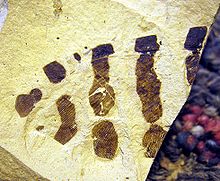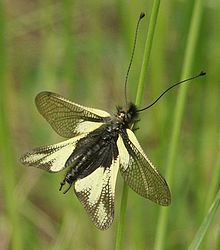Neuroptera
| Neuroptera Temporal range: Permian to recent
| |
|---|---|

| |
| Green lacewing | |
| Scientific classification | |
| Kingdom: | |
| Phylum: | |
| Class: | |
| Subclass: | |
| Infraclass: | |
| Superorder: | |
| Order: | Neuroptera |
| Suborders | |
|
and see text | |
The insect order Neuroptera, or net-winged insects, includes the lacewings, mantidflies, antlions, and their relatives. The order contains about 6,000 species.[1] The group was once known as Planipennia, and at that time also included alderflies, fishflies, dobsonflies, and snakeflies, but these are now generally considered to be separate orders (the Megaloptera and Raphidioptera). Sometimes the name Neuropterida[Note 1] is used to refer to these three orders as a group. This is either placed at superorder rank, with the Endopterygota becoming an unranked clade above it, or the Endopterygota are maintained as a superorder, with an unranked Neuropterida being a part of them. Within the endopterygotes, the closest living relatives of the neuropteridan clade are the beetles. The common name lacewings is often used for the most widely known net-winged insects – the green lacewings (Chrysopidae) – but actually most members of the Neuroptera are referred to as some sort of "lacewing".
The adults of this order possess four membranous wings, with the forewings and hindwings about the same size, and with many veins. They have chewing mouthparts, and undergo complete metamorphosis.
Neuropterans first appeared during the Permian Period, and continued to diversify through the Mesozoic Era.[2] During this time, several unusually large forms evolved, especially in the extinct family Kalligrammatidae, often referred to as "the butterflies of the Jurassic" due to their large, patterned wings.[3]
Anatomy and biology
Neuropterans are soft-bodied insects with relatively few specialised features. They have large lateral compound eyes, and may or may not also have ocelli. Their mouthparts have strong mandibles suitable for chewing, and lack the various adaptations found in most other endopterygote insect groups.
They have four wings, which are usually similar in size and shape, and a generalised pattern of veins. Some neuropterans have specialised sense organs in their wings, or have bristles or other structures to link their wings together during flight.[4]
The larvae are specialised predators, with elongated mandibles adapted for piercing and sucking. The larval body form varies between different families, depending on the nature of their prey. In general, however, they have three pairs of thoracic legs, each ending in two claws. The abdomen often has adhesive discs on the last two segments.[4]
Life cycle and ecology
 | |
 |
 |
The larvae of most families are predators. Many chrysopids eat aphids and other pest insects, and have been used for biological control (either from commercial distributors, but also abundant and widespread in nature). Larvae in various families cover themselves in debris (sometimes including dead prey insects) as camouflage, taken to an extreme in the ant lions, which bury themselves completely out of sight and ambush prey from "pits" in the soil. Larvae of some Ithonidae are root feeders, and larvae of Sisyridae are aquatic, and feed on freshwater sponges. A few mantispids are parasites of spider egg sacs.
As in other holometabolic orders, the pupal stage generally is enclosed in some form of cocoon composed of silk and soil or other debris. The pupa eventually cuts its way out of the cocoon with its mandibles, and may even move about for a short while before undergoing the moult to the adult form.[4]
Adults of many groups are also predatory, but some do not feed, or consume only nectar.
Taxonomy and systematics
The understanding of neuropteran phylogeny has vastly improved since the mid-1990s, not the least courtesy of the ever-growing fossil record.[1] In 1995, for example, it was simply known that the Megaloptera and Raphidioptera were not part of the Neuroptera in the strict sense, and the Mantispoidea and part of the Myrmeleontoidea were the only groups that could be confirmed by cladistic analysis.[5] Though the relationships of some families remain to be fully understood, most major lineages of the Neuropterida can nowadays be robustly placed in an evolutionary context.[Note 2]







Apart from a few groups that are quite basal or of uncertain position, the net-winged insects can be divided into two suborders, the Myrmeleontiformia and the Hemerobiiformia. The primitive Nevrorthidae, the most ancient group of living neuropterans, are sometimes considered a third suborder Nevrorthiformia or included in the Hemerobiiformia and more specifically in the Osmyloidea, but actually they are better considered a very basal lineage.[6]
Basal and unresolved forms
- Genus Mantispidiptera Grimaldi, 2000 (Late Cretaceous; New Jersey; formerly Mantispidae)
- Genus Mesohemerobius Ping, 1928(Late Jurassic/Early Cretaceous; China)
- Family Permithonidae (fossil, probably paraphyletic)
- Family Prohemerobiidae (fossil, probably paraphyletic)
- Family Nevrorthidae[Note 3]
- Family Grammosmylidae (fossil)
Suborder Hemerobiiformia
- Incertae sedis
- Family Osmylitidae (fossil, probably paraphyletic)
- Superfamily Ithonioidea
- Family Ithonidae: moth lacewings (includes Rapismatidae)
- Family Polystoechotidae: giant lacewings (formerly in Hemerobioidea)
- Superfamily Osmyloidea
- Family Osmylidae: osmylids
- Superfamily Chrysopoidea
- Family Ascalochrysidae (fossil)
- Family Mesochrysopidae (fossil)
- Family Chrysopidae: green lacewings, stinkflies (formerly in Hemerobioidea)
- Superfamily Hemerobioidea
- Family Hemerobiidae: brown lacewings
- Superfamily Coniopterygoidea
- Family Coniopterygidae: dustywings
- Family Sisyridae: spongillaflies (formerly in Osmyloidea, tentatively placed here)
- Superfamily Mantispoidea
- Family Dilaridae: pleasing lacewings (formerly in Hemerobioidea)
- Family Mantispidae: mantidflies
- Family Mesithonidae (fossil, probably paraphyletic)
- Family Rhachiberothidae: thorny lacewings
- Family Berothidae: beaded lacewings
Suborder Myrmeleontiformia
- Superfamily Nemopteroidea[Note 4]
- Family Kalligrammatidae (fossil)
- Family Psychopsidae: silky lacewings (formerly in Hemerobioidea)
- Family Nemopteridae: spoonwings, spoon-winged laceflies, thread-winged laceflies (formerly in Myrmeleontoidea)
- Superfamily Myrmeleontoidea
- Family Osmylopsychopidae (fossil)
- Family Nymphitidae (fossil)
- Family Solenoptilidae (fossil, probably paraphyletic)
- Family Brogniartiellidae (fossil)
- Family Nymphidae: split-footed lacewings (includes Myiodactylidae)
- Family Babinskaiidae (fossil)
- Family Myrmeleontidae: antlions (includes Palaeoleontidae)
- Family Ascalaphidae: owlflies, ascalaphids
Footnotes
- ^ Also called "Neuropteroidea", though the ending "-oidea" is normally used for superfamilies.
- ^ See references in Haaramo (2008).[6]
- ^ "Neurorthidae" is a lapsus.
- ^ Not in Haaramo (2008), but this taxon, for some time considered obsolete following questions about the affiliations of the Osmylopsychopidae, warrants acceptance as the three families therein form a clade.
References
- ^ a b David Grimaldi & Michael S. Engel (2005). Evolution of the Insects. Cambridge University Press. ISBN 0-521-82149-5.
- ^ A. G. Ponomarenko & D. E. Shcherbakov (2004). "New lacewings (Neuroptera) from the terminal Permian and basal Triassic of Siberia" (PDF). Paleontological Journal. 38 (S2): S197 – S203.
- ^ Michael S. Engel (2005). "A remarkable kalligrammatid lacewing from the Upper Jurassic of Kazakhstan (Neuroptera: Kalligrammatidae)". Transactions of the Kansas Academy of Science. 108 (1): 59–62. doi:10.1660/0022-8443(2005)108[0059:ARKLFT]2.0.CO;2.
- ^ a b c Hoell, H.V., Doyen, J.T. & Purcell, A.H. (1998). Introduction to Insect Biology and Diversity, 2nd ed. Oxford University Press. pp. 447–450. ISBN 0-19-510033-6.
{{cite book}}: CS1 maint: multiple names: authors list (link) - ^ John D. Oswald (1995). "Neuroptera. Lacewings, antlions, owlflies, etc". Tree of Life Web Project. Retrieved September 2, 2010.
- ^ a b Mikko Haaramo (March 11, 2008). "Neuroptera". Mikko's Phylogeny Archive. Retrieved April 27, 2008.
External links
- Illustrated database of Neuroptera (insects)
- Bibliography of the Neuropterida A database of Neuroptera related scientific literature
- Brown lacewings of Florida on the University of Florida / Institute of Food and Agricultural Sciences Featured Creatures website

